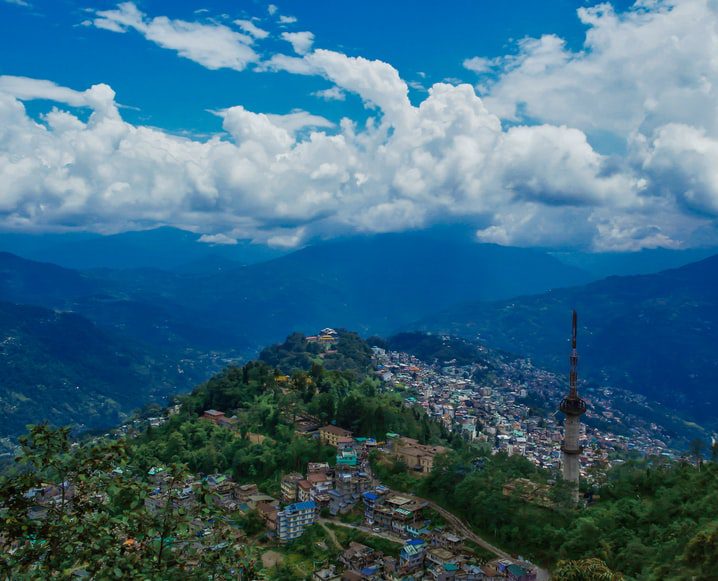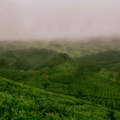Your Travel Guide to Sikkim 

Dripping with awe-inspiring mountainscapes, postcard-perfect valleys, soothing monasteries, and aquamarine blue waters, Sikkim is nothing short of a paradise. Each hamlet, town and city of this tiny state promises large landscapes that will leave an indelible mark. The corners, nooks and crannies of this state echo an enticing charm, justifiably making it a loved tourist destination. The transcendent beauty is simply unmatched and must be experienced in person.
If you are planning the much-coveted trip to Sikkim, here we are, as your virtual Sikkim tour guide.
- How to reach Sikkim
- Best time to visit Sikkim
- Places to visit in Sikkim
- Things to keep in mind while travelling in Sikkim
How to reach Sikkim?
This quaint, tiny state is well-connected by all modes of transportation, especially the capital city of Sikkim, Gangtok. It is flocked by tourists from all over the country, making it a tourist hot spot.
By Air
The nearest airport to Gangtok, Sikkim is Bagdogra Airport, which is approximately 125 km. away from Gangtok, Sikkim. Majority of the airlines have regular flights to Bagdogra Airport from most of the metro cities including Mumbai, Delhi and Bangalore. Once you land, you can rent a private taxi to Gangtok, which is approximately a 5-hour drive, boasting scenic views and winding roads.
Sikkim does have its own airport, in Gangtok, which is one of the highest airports in India. However, the frequency of flights at Pakyong Airport is relatively low, hence it is recommended to take flight to Bagdogra and then embark on your journey by road.
By Rail
The nearest railway station to Sikkim is New Jalpaiguri, which is approximately 120 km. away from Gangtok. There are several trains connecting to this station from the major cities including Delhi, Mumbai, Chennai, Bengaluru and Kochi. Private taxis to Gangtok are readily available outside the station.
By Road
If you are planning on journeying via the road, then we say go for it! The roads to Gangtok are extremely well-connected and boast stunning landscapes that must be experienced in person! Many travellers embark on a road trip from Siliguri, Darjeeling and Kalimpong to Gangtok. There are many private luxury buses along with state-run buses. Buses are not only economical but guarantee a road trip to remember!
Best time to visit Sikkim
The north-eastern belt of India is wrapped in unparalleled landscapes of mountains and valleys. One of the most famous places in the northeast of India, Sikkim attracts a flock of tourists looking to experience and witness the beauty of the state. The best time to visit Sikkim is during the months of March to May when spring sets in and makes the state shine in all its glory. You can also plan your trip in the months of October to mid-December when the winter is bearable. Visiting the state during the monsoon season is certainly not recommended, as Sikkim sees heavy rainfalls. The unpredictability during the monsoon season would not only hamper your travel plans but also, you wouldn’t be able to visit as many places.

Places to visit in Sikkim
Gurudongmar Lake, North Sikkim
North Sikkim boasts stunning panoramas, and Gurudongmar Lake is no exception. Only accessible to Indian Nationals given its proximity to Indo-Chinese border, it overlooks the mesmerizing Kanchendzonga range and Mount Siniolchu. The altitude of the lake makes it inhabitable, hence, you are unlikely to find any accommodation in the vicinity. Tourists often reside at quaint homestays in Sikkim Lachen, and visit Gurudongmar Lake from there. Apart from the pristine waters, you may even spot the rare Bhramhakamal, that is known for its healing properties.

Nathu La Pass, East Sikkim
Located approximately 55 km. away from Gangtok, Nathu La Pass is an extremely famed tourist attraction and is a significant trade link between India and China. At a staggering elevation of 14,500 ft., it is prone to landslides and avalanches. Nathu La Pass overlooks the breathtaking snowcapped Himalayan ranges, making it a sight to savour. Only Indian nationals can access the pass, and it remains open only a few days in a week. However, do keep in mind that special permissions from the Army authorities in Gangtok need to be taken at least 24 hours in advance, as the pass is a significant military post for the Indian Army. Given its high altitude and low levels of oxygen, Nathu La Pass may not be suitable for senior citizens, adults with health issues and children.

Tsomgo Lake, East Sikkim
One of the many Sikkim places to visit, Tsomgo Lake, or Changu Lake as it is often called, is a sight to behold. The glacial lake completely freezes during the winter months, making it almost bewitching. The alluring charisma of the lake itself is complemented by the soaring Himalayan peaks, making for a perfect backdrop. The lake offers a glimpse of the fauna of Sikkim. En route to Nathu La Pass, during spring, the lake is encircled by blooming flowers and fluttering birds. The gentle humming, the aqua blue hues of the lake and the white mountains at the back, altogether make this a must-visit.

Pemayangtse Monastery, West Sikkim
The west of Sikkim houses Pelling, which is approximately 115 km. away from the capital city of Gangtok. Pelling promises the best views of the Kanchenjunga mountain range. Merely 2 km. away from Pelling lies Pemayangste Monastery, which is one of the many famous tourist places of Sikkim. The oldest and one of the most significant monasteries, it is tucked away on a hill and below it lies the Rangit River. The monastery features ancient scriptures, sculptures, statue of Padmasambhava (main lord of Tibetan Buddhism).

Kanchenjunga National Park, West Sikkim
In your long itinerary, Kanchenjunga National Park must make an appearance. An absolute must for nature-enthusiasts, this national park is one of the few parks located at a commendable altitude. Also known as the Kanchenjunga Biosphere Reserve, the majestic Kanchenjunga peaks hang above the park. The national park itself is swathed in clear lakes, plunging gorges and stunning landscapes. Spottings include Himalayan blue sheep, the Asiatic wild dog and red pandas. However, a visit to the park requires permission from State Tourism Department or the Wildlife Education and Interpretation Centre in Yuksom.

Temi Tea Plantations
Known for its monasteries, rising peaks and stunning landscapes, Sikkim is also famed for verdant tea plantations. All chai-lovers are certainly in for a treat. The story behind Temi Tea Plantations is interesting indeed. The tea gardens were set up by the local government authorities to aid the Tibetan refugees in terms of employment. The tea gardens produce a variety of tea, including black tea, green tea and white tea. The gardens also feature an onsite cafe, perfect to relish a hot cuppa!

Things to keep in mind while travelling to Sikkim
- There are several restricted areas in Sikkim. Hence, one thing to keep in mind about Sikkim is that if you are planning to visit North Sikkim and East Sikkim, make sure to get an inner line permit, which is mandatory. If you have booked your trip through a tour operator, they can help you secure this permit with the relevant documents.
- Visiting the State during the monsoon season is certainly not recommended as the North-eastern belt of India is one of the wettest regions in the world.
- Research well before your trip, especially if it is your first time. It is suggested to get yourself a tour guide if possible.
- Regardless of the season you visit Sikkim in, ensure to load up on all the winter clothes as the state is known for its winter chills.
- Sikkim is home to various monasteries; it’s highly suggested that the decorum is maintained here.
- Bear in mind that Sikkim is located at a high altitude, and many of its tourist attractions may have lower levels of Oxygen.
- Carry all your valid ID proofs.





